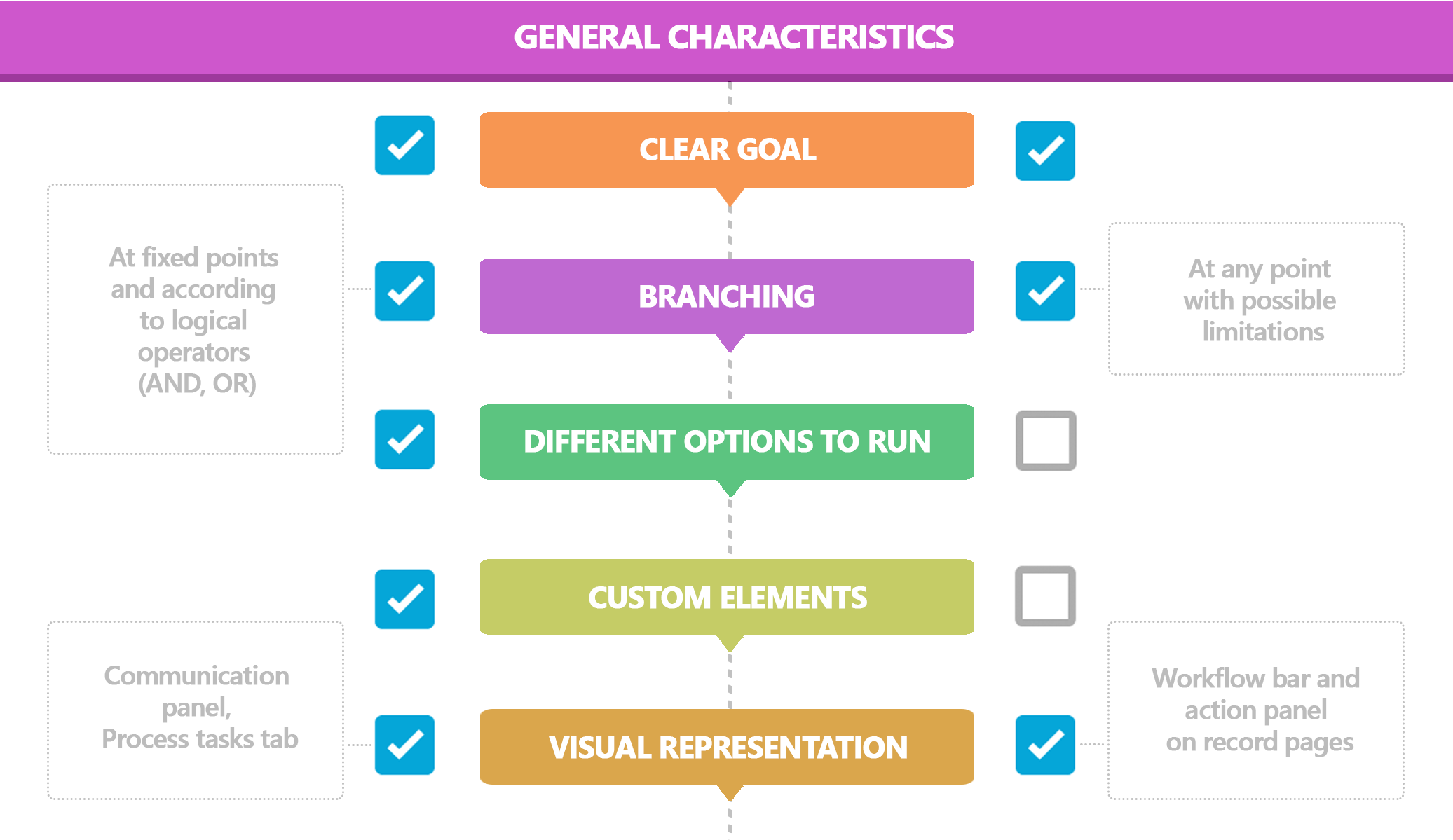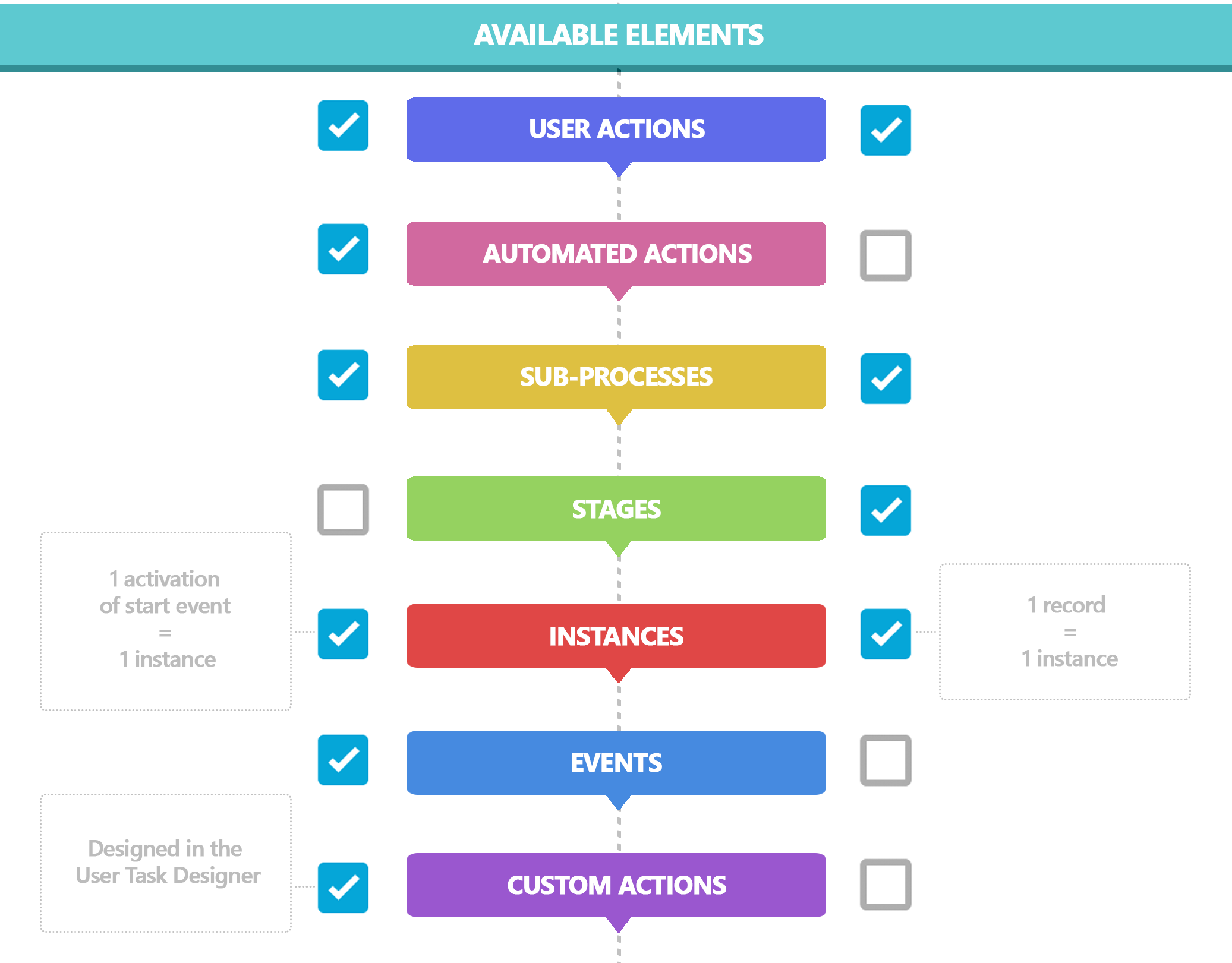Creatio is based on a business process management platform that uses two types of business processes:
-
BPMN business processes generally follow BPMN 2.0 notation. Using BPMN tools, you can create and maintain highly structured sequences of actions, both automated and those performed by the users. This is the best tool for creating custom business logic, such as integrations, custom UI, etc., as well as automating routine processes.
-
Dynamic cases are a type of flexible business processes, which generally follow a life cycle of a Creatio record: a document, an opportunity, an order, etc. Dynamic cases streamline and organize employee workflow, prompt them the activities needed to achieve positive result for the current record (e.g., activities needed to successfully go through the deal stages when processing an opportunity).
Note
For more information on the BPMN processes and dynamic cases, we recommend that you take “Introduction to business processes” e-learning module (academy registration is required).
Here’s an overview of how the two types of processes compare to each other:




How to use Case Designer guide
Cases are fairly straightforward. If you are new to dynamic cases, we encourage you to start with the “Case Designer guide” chapter, as well as take the “How to set up dynamic cases” module.
If you generally understand what cases and their management tools are, and simply need an example to get you started, go to the “How to set up a case with approval” chapter, which is a step-by-step guide for setting up an approval process.
Detailed reference on the different case elements is available in the “Case Designer elements reference” chapter. This chapter will be useful for users who already know how to design a case, and need to clarify some specifics as to how different “building blocks” operate in Creatio cases.
How to use Process Designer guide
Business processes in Creatio are tools for in-depth customization of business logic. Using business processes requires good knowledge of Creatio functionality than you plan to customize or automate with BPMN processes. This guide was designed for users with different levels of knowledge of BPMS.
If you are new to BPMN in general, and business process implementation in Creatio in particular, we recommend that you start with basics that are available in the Process Designer guide. It contains introduction to base concepts behind the BPMN engine in Creatio:
-
Getting started with Process Designer – this chapter contains information on the Process Designer interface.
-
Elements and flows – this chapter covers the basics of working with primary business process elements – actions and flows in Creatio Process Designer.
-
Branching processes – this chapter covers working with special type of process elements: gateways, also known as “Logic operators”, used to converge and diverge process flow.
-
Process events – this chapter covers events, which are means of starting an stopping a business process, and can be used to set up processes that would run automatically.
-
Process parameters – covers the logic behind process and element parameters, which determine how process elements execute, and can be used to exchange information within a business process.
-
Working with data – in this chapter you will learn how business processes interact with Creatio database and its records.
-
Formulas – this chapter covers basic principles and syntax of working with formulas in a business process for calculating values, generating dynamic text or setting up logic conditions.
-
Advanced process settings – this chapter briefly touches upon process-wide settings.
-
Process version control – in this chapter you will learn how Creatio lets you update and modify processes without disrupting the flow of the processes that are already in use.
-
Process Designer best practices – contains general recommendations on how to get best performance out of your Creatio business processes.
If you already understand the basics behind business processes in Creatio, and are looking for practical examples of how to implement specific business cases vial a BPMN process, we recommend that you browse those available in the Business process use cases chapter. It contains two types of cases.
First, there are simple use cases of implementing different functions, logic and elements of a BPMN process. The purpose of these use cases is to demonstrate how to you achieve specific business tasks using a BPMN process:
The “End-to-end use cases” chapter contains instructions on how to set up completely functional business processes, from start to finish.
If you are a confident BPMS user and already know how to design a business process, and need to clarify some specifics as to how different process elements operate in Creatio, you can skip basics and examples, and go straight to the “Process Designer elements reference” chapter.
Creatio Marketplace content
Check Creatio marketplace for free business process templates illustrating different aspects of Creatio business process. These are examples of processes covered in the Process Designer guide.
-
Business processes: start events template contains examples mentioned in the Process events article.
-
Business processes: parameters template contains examples mentioned in the Process parameters article.
-
Business processes: basic steps in working with data template contains examples mentioned in the Working with data article.
Examples of Marketplace business process templates:
-
Engaging dormant customers – is a great template illustrating how to create a cyclic business process in Creatio.
-
Granting new owner access rights to the account data – this template provides a practical example on how to manage access rights as part of a business process flow.
-
Employee on-boarding – a working process for handling a new hire, with all common practices found in Creatio process design.
-
Feed notifications on account related events – an example of automating notifications using BPMN business process.






